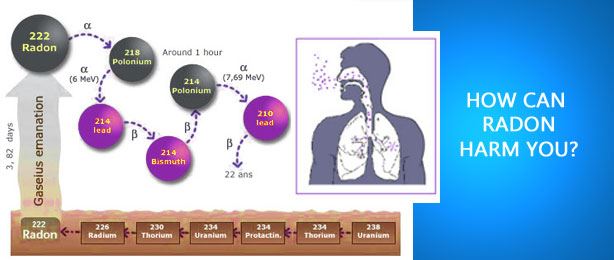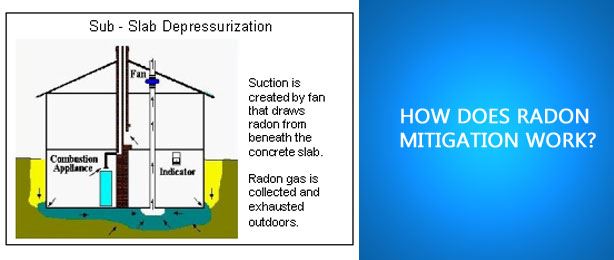|
- Home
- Links and Resources
- What Is Radon?
What is Radon?
Radon is an odorless, colorless, chemically inert but radioactive gas that occurs naturally all across the U.S at varying concentrations. It is a decay product of uranium and radium present in bedrock, and its own decay products are also radioactive. Because radon is a gas, it moves easily up through soil. It also can be dissolved in and carried by groundwater and natural gas. Outdoors there is no problem because the gas gets diluted and blown away before it can decay. In your home or business environments, the gas can build up and that’s when the trouble starts.
Where Does Radon Come From?
Radon comes initially from the decay of Uranium which then becomes radium and then finally radon. Therefore many rocks in the bedrock found under homes, schools, or businesses could have these source rocks associated with them and could pose a threat to the inhabitants above them.
How Can Radon Harm You?
 When radon decays, its “RDP’s” or radon decay products can become attached to dust in the air you breath. These RDP’s then decay in your lungs, releasing alpha radiation that damages your cells and increases the risk of lung cancer. The effect was first seen in uranium miners, but today the threat goes far beyond just them.
When radon decays, its “RDP’s” or radon decay products can become attached to dust in the air you breath. These RDP’s then decay in your lungs, releasing alpha radiation that damages your cells and increases the risk of lung cancer. The effect was first seen in uranium miners, but today the threat goes far beyond just them.
EPA estimates that about 21,000 lung cancer deaths each year in the U.S. are radon-related. Exposure to radon is the second leading cause of lung cancer after smoking. Radon is an odorless, tasteless and invisible gas produced by the decay of naturally occurring uranium in soil and water. Radon is a form of ionizing radiation and a proven carcinogen. Lung cancer is the only known effect on human health from exposure to radon in air. Thus far, there is no evidence that children are at greater risk of lung cancer than are adults.Radon is found in outdoor air and in the indoor air of buildings of all kinds. EPA recommends homes be fixed if the radon level is 4 pCi/L (picocuries per liter) or more. Because there is no known safe level of exposure to radon, EPA also recommends that Americans consider fixing their home for radon levels between 2 pCi/L and 4 pCi/L. The average radon concentration in the indoor air of america’s homes is about 1.3 pCi/L. It is upon this level that EPA based its estimate of 21,000 radon-related lung cancers a year upon. It is for this simple reason that EPA recommends that Americans consider fixing their homes when the radon level is between 2 pCi/L and 4 pCi/L. The average concentration of radon in outdoor air is .4 pCi/L or 1/10thof EPA’s 4 pCi/L action level.
How Does Radon Enter Your Home?
 Radon enters buildings many ways. It comes in through joints, cracks, in concrete walls or floors, openings in drains or sump pits, and gaps in plumbing passageways – it can be found even in well water or natural gas (shale gas). The more sealed up your windows and doors are (as with today’s energy constructions), the more radon gets concentrated in the inside air.
Radon enters buildings many ways. It comes in through joints, cracks, in concrete walls or floors, openings in drains or sump pits, and gaps in plumbing passageways – it can be found even in well water or natural gas (shale gas). The more sealed up your windows and doors are (as with today’s energy constructions), the more radon gets concentrated in the inside air.
How Does Radon Mitigation Work?
 The majority of radon mitigation systems today address the air pressure differences between the soil beneath the home and the property itself. The objective is to depressurize the material beneath the slab of the home by pulling air from under the foundation. This is typically done by coring a hole through the floor of the basement and routing the piping either through the home exiting through the roof or by running the piping external along the outside of the home to the roofline. The suction is then achieved by adding an active mechanism to pull the air from beneath the floor. Radon mitigation systems which are active will have a fan mounted inline with the piping to help move air from under the dwelling to the outside environment. Radon mitigation systems can range greatly from residential to commercial applications and should only be installed by a licensed radon mitigation company. In most cases radon mitigation can drastically reduce radon levels in many different floor plans and even in larger footprints
The majority of radon mitigation systems today address the air pressure differences between the soil beneath the home and the property itself. The objective is to depressurize the material beneath the slab of the home by pulling air from under the foundation. This is typically done by coring a hole through the floor of the basement and routing the piping either through the home exiting through the roof or by running the piping external along the outside of the home to the roofline. The suction is then achieved by adding an active mechanism to pull the air from beneath the floor. Radon mitigation systems which are active will have a fan mounted inline with the piping to help move air from under the dwelling to the outside environment. Radon mitigation systems can range greatly from residential to commercial applications and should only be installed by a licensed radon mitigation company. In most cases radon mitigation can drastically reduce radon levels in many different floor plans and even in larger footprints

